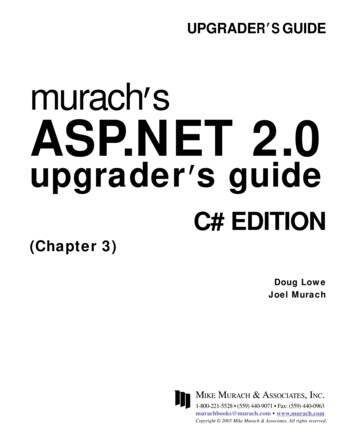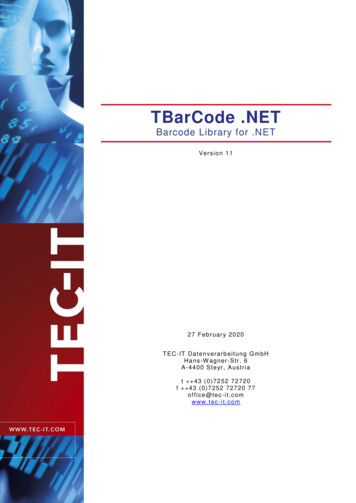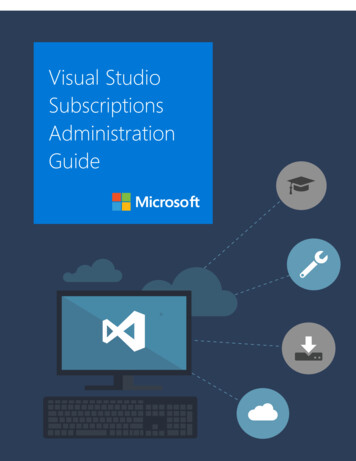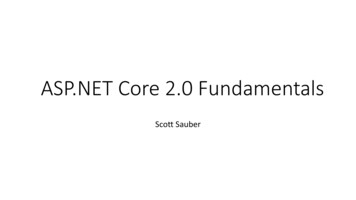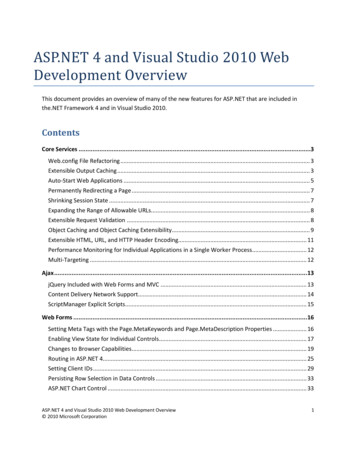
Transcription
ASP.NET 4 and Visual Studio 2010 WebDevelopment OverviewThis document provides an overview of many of the new features for ASP.NET that are included inthe.NET Framework 4 and in Visual Studio 2010.ContentsCore Services .3Web.config File Refactoring . 3Extensible Output Caching . 3Auto-Start Web Applications . 5Permanently Redirecting a Page . 7Shrinking Session State . 7Expanding the Range of Allowable URLs. 8Extensible Request Validation . 8Object Caching and Object Caching Extensibility. 9Extensible HTML, URL, and HTTP Header Encoding. 11Performance Monitoring for Individual Applications in a Single Worker Process. 12Multi-Targeting . 12Ajax . 13jQuery Included with Web Forms and MVC . 13Content Delivery Network Support. 14ScriptManager Explicit Scripts. 15Web Forms . 16Setting Meta Tags with the Page.MetaKeywords and Page.MetaDescription Properties . 16Enabling View State for Individual Controls. 17Changes to Browser Capabilities. 19Routing in ASP.NET 4. 25Setting Client IDs . 29Persisting Row Selection in Data Controls . 33ASP.NET Chart Control . 33ASP.NET 4 and Visual Studio 2010 Web Development Overview 2010 Microsoft Corporation1
Filtering Data with the QueryExtender Control . 36Html Encoded Code Expressions . 39Project Template Changes . 40CSS Improvements . 45Hiding div Elements Around Hidden Fields . 47Rendering an Outer Table for Templated Controls . 47ListView Control Enhancements . 49CheckBoxList and RadioButtonList Control Enhancements . 49Menu Control Improvements . 51Wizard and CreateUserWizard Controls . 52ASP.NET MVC . 55Areas Support. 55Data-Annotation Attribute Validation Support. 55Templated Helpers . 55Dynamic Data . 55Enabling Dynamic Data for Existing Projects . 56Declarative DynamicDataManager Control Syntax. 57Entity Templates . 57New Field Templates for URLs and E-mail Addresses . 59Creating Links with the DynamicHyperLink Control . 60Support for Inheritance in the Data Model . 60Support for Many-to-Many Relationships (Entity Framework Only) . 60New Attributes to Control Display and Support Enumerations . 60Enhanced Support for Filters . 61Visual Studio 2010 Web Development Improvements . 61Improved CSS Compatibility . 61HTML and JavaScript Snippets . 62JavaScript IntelliSense Enhancements . 62Web Application Deployment with Visual Studio 2010 . 62Web Packaging . 63Web.config Transformation . 63Database Deployment. 64One-Click Publish for Web Applications. 64ASP.NET 4 and Visual Studio 2010 Web Development Overview 2010 Microsoft Corporation2
Resources . 64Disclaimer. 66Core ServicesASP.NET 4 introduces a number of features that improve core ASP.NET services such as output cachingand session-state storage.Web.config File RefactoringThe Web.config file that contains the configuration for a Web application has grown considerably overthe past few releases of the .NET Framework as new features have been added, such as Ajax, routing,and integration with IIS 7. This has made it harder to configure or start new Web applications without atool like Visual Studio. In .the NET Framework 4, the major configuration elements have been moved tothe machine.config file, and applications now inherit these settings. This allows the Web.config file inASP.NET 4 applications either to be empty or to contain just the following lines, which specify for VisualStudio what version of the framework the application is targeting: ?xml version "1.0"? configuration system.web compilation targetFramework "4.0" / /system.web /configuration Extensible Output CachingSince the time that ASP.NET 1.0 was released, output caching has enabled developers to store thegenerated output of pages, controls, and HTTP responses in memory. On subsequent Web requests,ASP.NET can serve content more quickly by retrieving the generated output from memory instead ofregenerating the output from scratch. However, this approach has a limitation — generated contentalways has to be stored in memory, and on servers that are experiencing heavy traffic, the memoryconsumed by output caching can compete with memory demands from other portions of a Webapplication.ASP.NET 4 adds an extensibility point to output caching that enables you to configure one or morecustom output-cache providers. Output-cache providers can use any storage mechanism to persistHTML content. This makes it possible to create custom output-cache providers for diverse persistencemechanisms, which can include local or remote disks, cloud storage, and distributed cache engines.ASP.NET 4 and Visual Studio 2010 Web Development Overview 2010 Microsoft Corporation3
You create a custom output-cache provider as a class that derives from the newSystem.Web.Caching.OutputCacheProvider type. You can then configure the provider in the Web.configfile by using the new providers subsection of the outputCache element, as shown in the followingexample: caching outputCache defaultProvider "AspNetInternalProvider" providers add name "DiskCache"type "Test.OutputCacheEx.DiskOutputCacheProvider, DiskCacheProvider"/ /providers /outputCache /caching By default in ASP.NET 4, all HTTP responses, rendered pages, and controls use the in-memory outputcache, as shown in the previous example, where the defaultProvider attribute is set toAspNetInternalProvider. You can change the default output-cache provider used for a Webapplication by specifying a different provider name for defaultProvider.In addition, you can select different output-cache providers per control and per request. The easiest wayto choose a different output-cache provider for different Web user controls is to do so declaratively byusing the new providerName attribute in a control directive, as shown in the following example: %@ OutputCache Duration "60" VaryByParam "None" providerName "DiskCache" % Specifying a different output cache provider for an HTTP request requires a little more work. Instead ofdeclaratively specifying the provider, you override the new GetOuputCacheProviderName method in theGlobal.asax file to programmatically specify which provider to use for a specific request. The followingexample shows how to do this.public override string GetOutputCacheProviderName(HttpContext context){if turn "DiskCache";elsereturn base.GetOutputCacheProviderName(context);}With the addition of output-cache provider extensibility to ASP.NET 4, you can now pursue moreaggressive and more intelligent output-caching strategies for your Web sites. For example, it is nowpossible to cache the "Top 10" pages of a site in memory, while caching pages that get lower traffic onASP.NET 4 and Visual Studio 2010 Web Development Overview 2010 Microsoft Corporation4
disk. Alternatively, you can cache every vary-by combination for a rendered page, but use a distributedcache so that the memory consumption is offloaded from front-end Web servers.Auto-Start Web ApplicationsSome Web applications need to load large amounts of data or perform expensive initializationprocessing before serving the first request. In earlier versions of ASP.NET, for these situations you had todevise custom approaches to "wake up" an ASP.NET application and then run initialization code duringthe Application Load method in the Global.asax file.A new scalability feature named auto-start that directly addresses this scenario is available whenASP.NET 4 runs on IIS 7.5 on Windows Server 2008 R2. The auto-start feature provides a controlledapproach for starting up an application pool, initializing an ASP.NET application, and then acceptingHTTP requests.IIS Application Warm-Up Module for IIS 7.5The IIS team has released the first beta test version of the Application Warm-Up Module for IIS7.5. This makes warming up your applications even easier than previously described. Instead ofwriting custom code, you specify the URLs of resources to execute before the Web applicationaccepts requests from the network. This warm-up occurs during startup of the IIS service (if youconfigured the IIS application pool as AlwaysRunning) and when an IIS worker process recycles.During recycle, the old IIS worker process continues to execute requests until the newlyspawned worker process is fully warmed up, so that applications experience no interruptions orother issues due to unprimed caches. Note that this module works with any version of ASP.NET,starting with version 2.0.For more information, see Application Warm-Up on the IIS.net Web site. For a walkthrough thatillustrates how to use the warm-up feature, see Getting Started with the IIS 7.5 ApplicationWarm-Up Module on the IIS.net Web site.To use the auto-start feature, an IIS administrator sets an application pool in IIS 7.5 to be automaticallystarted by using the following configuration in the applicationHost.config file: applicationPools add name "MyApplicationPool" startMode "AlwaysRunning" / /applicationPools Because a single application pool can contain multiple applications, you specify individual applications tobe automatically started by using the following configuration in the applicationHost.config file: sites ASP.NET 4 and Visual Studio 2010 Web Development Overview 2010 Microsoft Corporation5
site name "MySite" id "1" application path "/"serviceAutoStartEnabled "true"serviceAutoStartProvider "PrewarmMyCache" !-- Additional content -- /application /site /sites !-- Additional content -- serviceAutoStartProviders add name "PrewarmMyCache"type "MyNamespace.CustomInitialization, MyLibrary" / /serviceAutoStartProviders When an IIS 7.5 server is cold-started or when an individual application pool is recycled, IIS 7.5 uses theinformation in the applicationHost.config file to determine which Web applications need to beautomatically started. For each application that is marked for auto-start, IIS7.5 sends a request toASP.NET 4 to start the application in a state during which the application temporarily does not acceptHTTP requests. When it is in this state, ASP.NET instantiates the type defined by theserviceAutoStartProvider attribute (as shown in the previous example) and calls into its public entrypoint.You create a managed auto-start type with the necessary entry point by implementing theIProcessHostPreloadClient interface, as shown in the following example:public class CustomInitialization : c void Preload(string[] parameters){// Perform initialization.}}After your initialization code runs in the Preload method and the method returns, the ASP.NETapplication is ready to process requests.With the addition of auto-start to IIS .5 and ASP.NET 4, you now have a well-defined approach forperforming expensive application initialization prior to processing the first HTTP request. For example,ASP.NET 4 and Visual Studio 2010 Web Development Overview 2010 Microsoft Corporation6
you can use the new auto-start feature to initialize an application and then signal a load-balancer thatthe application was initialized and ready to accept HTTP traffic.Permanently Redirecting a PageIt is common practice in Web applications to move pages and other content around over time, whichcan lead to an accumulation of stale links in search engines. In ASP.NET, developers have traditionallyhandled requests to old URLs by using by using the Response.Redirect method to forward a request tothe new URL. However, the Redirect method issues an HTTP 302 Found (temporary redirect) response,which results in an extra HTTP round trip when users attempt to access the old URLs.ASP.NET 4 adds a new RedirectPermanent helper method that makes it easy to issue HTTP 301 MovedPermanently responses, as in the following aspx");Search engines and other user agents that recognize permanent redirects will store the new URL that isassociated with the content, which eliminates the unnecessary round trip made by the browser fortemporary redirects.Shrinking Session StateASP.NET provides two default options for storing session state across a Web farm: a session-stateprovider that invokes an out-of-process session-state server, and a session-state provider that storesdata in a Microsoft SQL Server database. Because both options involve storing state information outsidea Web application's worker process, session state has to be serialized before it is sent to remote storage.Depending on how much information a developer saves in session state, the size of the serialized datacan grow quite large.ASP.NET 4 introduces a new compression option for both kinds of out-of-process session-stateproviders. When the compressionEnabled configuration option shown in the following example is set totrue, ASP.NET will compress (and decompress) serialized session state by using the .NET FrameworkSystem.IO.Compression.GZipStream class. sessionStatemode "SqlServer"sqlConnectionString "data source dbserver;Initial Catalog aspnetstate"allowCustomSqlDatabase "true"compressionEnabled "true"/ ASP.NET 4 and Visual Studio 2010 Web Development Overview 2010 Microsoft Corporation7
With the simple addition of the new attribute to the Web.config file, applications with spare CPU cycleson Web servers can realize substantial reductions in the size of serialized session-state data.Expanding the Range of Allowable URLsASP.NET 4 introduces new options for expanding the size of application URLs. Previous versions ofASP.NET constrained URL path lengths to 260 characters, based on the NTFS file-path limit. In ASP.NET 4,you have the option to increase (or decrease) this limit as appropriate for your applications, using twonew httpRuntime configuration attributes. The following example shows these new attributes. httpRuntime maxRequestPathLength "260" maxQueryStringLength "2048" / To allow longer or shorter paths (the portion of the URL that does not include protocol, server name,and query string), modify the maxRequestPathLength attribute. To allow longer or shorter query strings,modify the value of the maxQueryStringLength attribute.ASP.NET 4 also enables you to configure the characters that are used by the URL character check. WhenASP.NET finds an invalid character in the path portion of a URL, it rejects the request and issues an HTTP400 error. In previous versions of ASP.NET, the URL character checks were limited to a fixed set ofcharacters. In ASP.NET 4, you can customize the set of valid characters using the newrequestPathInvalidChars attribute of the httpRuntime configuration element, as shown in the followingexample: httpRuntime requestPathInvalidChars "<,>,*,%,&,:,\,?"/ By default, the requestPathInvalidChars attribute defines eight characters as invalid. (In the string that isassigned to requestPathInvalidChars by default, the less than ( ), greater than ( ), and ampersand (&)characters are encoded, because the Web.config file is an XML file.) You can customize the set ofinvalid characters as needed.Note ASP.NET 4 always rejects URL paths that contain characters in the ASCII range of 0x00 to 0x1F,because those are invalid URL characters as defined in RFC 2396 of the IETF(http://www.ietf.org/rfc/rfc2396.txt). On versions of Windows Server that run IIS 6 or higher, thehttp.sys protocol device driver automatically rejects URLs with these characters.Extensible Request ValidationASP.NET request validation searches incoming HTTP request data for strings that are commonly used incross-site scripting (XSS) attacks. If potential XSS strings are found, request validation flags the suspectstring and returns an error. The built-in request validation returns an error only when it finds the mostcommon strings used in XSS attacks. Previous attempts to make the XSS validation more aggressiveASP.NET 4 and Visual Studio 2010 Web Development Overview 2010 Microsoft Corporation8
resulted in too many false positives. However, customers might want request validation that is moreaggressive, or conversely might want to intentionally relax XSS checks for specific pages or for specifictypes of requests.In ASP.NET 4, the request validation feature has been made extensible so that you can use customrequest-validation logic. To extend request validation, you create a class that derives from the newSystem.Web.Util.RequestValidator type, and you configure the application (in the httpRuntime sectionof the Web.config file) to use the custom type. The following example shows how to configure a customrequest-validation class: httpRuntime requestValidationType "Samples.MyValidator, Samples" / The new requestValidationType attribute requires a standard .NET Framework type identifier string thatspecifies the class that provides custom request validation. For each request, ASP.NET invokes thecustom type to process each piece of incoming HTTP request data. The incoming URL, all the HTTPheaders (both cookies and custom headers), and the entity body are all available for inspection by acustom request validation class like that shown in the following example:public class CustomRequestValidation : RequestValidator{protected override bool IsValidRequestString(HttpContext context, string value,RequestValidationSource requestValidationSource,string collectionKey,out int validationFailureIndex){.}}For cases where you do not want to inspect a piece of incoming HTTP data, the request-validation classcan fall back to let the ASP.NET default request validation run by simply callingbase.IsValidRequestString.Object Caching and Object Caching ExtensibilitySince its first release, ASP.NET has included a powerful in-memory object cache(System.Web.Caching.Cache). The cache implementation has been so popular that it has been used innon-Web applications. However, it is awkward for a Windows Forms or WPF application to include areference to System.Web.dll just to be able to use the ASP.NET object cache.To make caching available for all applications, the .NET Framework 4 introduces a new assembly, a newnamespace, some base types, and a concrete caching implementation. The newASP.NET 4 and Visual Studio 2010 Web Development Overview 2010 Microsoft Corporation9
System.Runtime.Caching.dll assembly contains a new caching API in the System.Runtime.Cachingnamespace. The namespace contains two core sets of classes:Abstract types that provide the foundation for building any type of custom cache implementation.A concrete in-memory object cache implementation (the System.Runtime.Caching.MemoryCacheclass).The new MemoryCache class is modeled closely on the ASP.NET cache, and it shares much of theinternal cache engine logic with ASP.NET. Although the public caching APIs in System.Runtime.Cachinghave been updated to support development of custom caches, if you have used the ASP.NET Cacheobject, you will find familiar concepts in the new APIs.An in-depth discussion of the new MemoryCache class and supporting base APIs would require an entiredocument. However, the following example gives you an idea of how the new cache API works. Theexample was written for a Windows Forms application, without any dependency on System.Web.dll.private void btnGet Click(object sender, EventArgs e){//Obtain a reference to the default MemoryCache instance.//Note that you can create multiple MemoryCache(s) inside//of a single application.ObjectCache cache MemoryCache.Default;//In this example the cache is storing the contents of a filestring fileContents cache["filecontents"] as string;//If the file contents are not currently in the cache, then//the contents are read from disk and placed in the cache.if (fileContents null){//A CacheItemPolicy object holds all the pieces of cache//dependency and cache expiration metadata related to a single//cache entry.CacheItemPolicy policy new CacheItemPolicy();//Build up the information necessary to create a file dependency.//In this case we just need the file path of the file on disk.List string filePaths new List string ();filePaths.Add("c:\\data.txt");//In the new cache API, dependencies are called "change monitors".ASP.NET 4 and Visual Studio 2010 Web Development Overview 2010 Microsoft Corporation10
//For this example we want the cache entry to be automatically expired//if the contents on disk change. A HostFileChangeMonitor provides//this functionality.policy.ChangeMonitors.Add(new HostFileChangeMonitor(filePaths));//Fetch the file's contentsfileContents File.ReadAllText("c:\\data.txt");//And then store the file's contents in the cachecache.Set("filecontents", fileContents, policy);}MessageBox.Show(fileContents);}Extensible HTML, URL, and HTTP Header EncodingIn ASP.NET 4, you can create custom encoding routines for the following common text-encoding tasks:HTML encoding.URL encoding.HTML attribute encoding.Encoding outbound HTTP headers.You can create a custom encoder by deriving from the new System.Web.Util.HttpEncoder type and thenconfiguring ASP.NET to use the custom type in the httpRuntime section of the Web.config file, as shownin the following example: httpRuntime encoderType "Samples.MyCustomEncoder, Samples"/ After a custom encoder has been configured, ASP.NET automatically calls the custom encodingimplementation whenever public encoding methods of the System.Web.HttpUtility orSystem.Web.HttpServerUtility classes are called. This lets one part of a Web development team create acustom encoder that implements aggressive character encoding, while the rest of the Web developmentteam continues to use the public ASP.NET encoding APIs. By centrally configuring a custom encoder inthe httpRuntime element, you are guaranteed that all text-encoding calls from the public ASP.NETencoding APIs are routed through the custom encoder.ASP.NET 4 and Visual Studio 2010 Web Development Overview 2010 Microsoft Corporation11
Performance Monitoring for Individual Applications in a Single Worker ProcessIn order to increase the number of Web sites that can be hosted on a single server, many hosters runmultiple ASP.NET applications in a single worker process. However, if multiple applications use a singleshared worker process, it is difficult for server administrators to identify an individual application that isexperiencing problems.ASP.NET 4 leverages new resource-monitoring functionality introduced by the CLR. To enable thisfunctionality, you can add the following XML configuration snippet to the aspnet.config configurationfile. ?xml version "1.0" encoding "UTF-8" ? configuration runtime appDomainResourceMonitoring enabled "true"/ /runtime /configuration Note The aspnet.config file is in the directory where the .NET Framework is installed. It is not theWeb.config file.When the appDomainResourceMonitoring feature has been enabled, two new performance countersare available in the "ASP.NET Applications" performance category: % Managed Processor Time andManaged Memory Used. Both of these performance counters use the new CLR application-domainresource management feature to track estimated CPU time and managed memory utilization ofindividual ASP.NET applications. As a result, with ASP.NET 4, administrators now have a more granularview into the resource consumption of individual applications running in a single worker process.Multi-TargetingYou can create an application that targets a specific version of the .NET Framework. In ASP.NET 4, a newattribute in the compilation element of the Web.config file lets you target the .NET Framework 4 andlater. If you explicitly target the .NET Framework 4, and if you include optional elements in theWeb.config file such as the entries for system.codedom, these elements must be correct for the .NETFramework 4. (If you do not explicitly target the .NET Framework 4, the target framework is inferredfrom the lack of an entry in the Web.config file.)The following example shows the use of the targetFramework attribute in the compilation ele
ASP.NET 4 and Visual Studio 2010 Web Development Overview 4 2010 Microsoft Corporation You create a custom o

